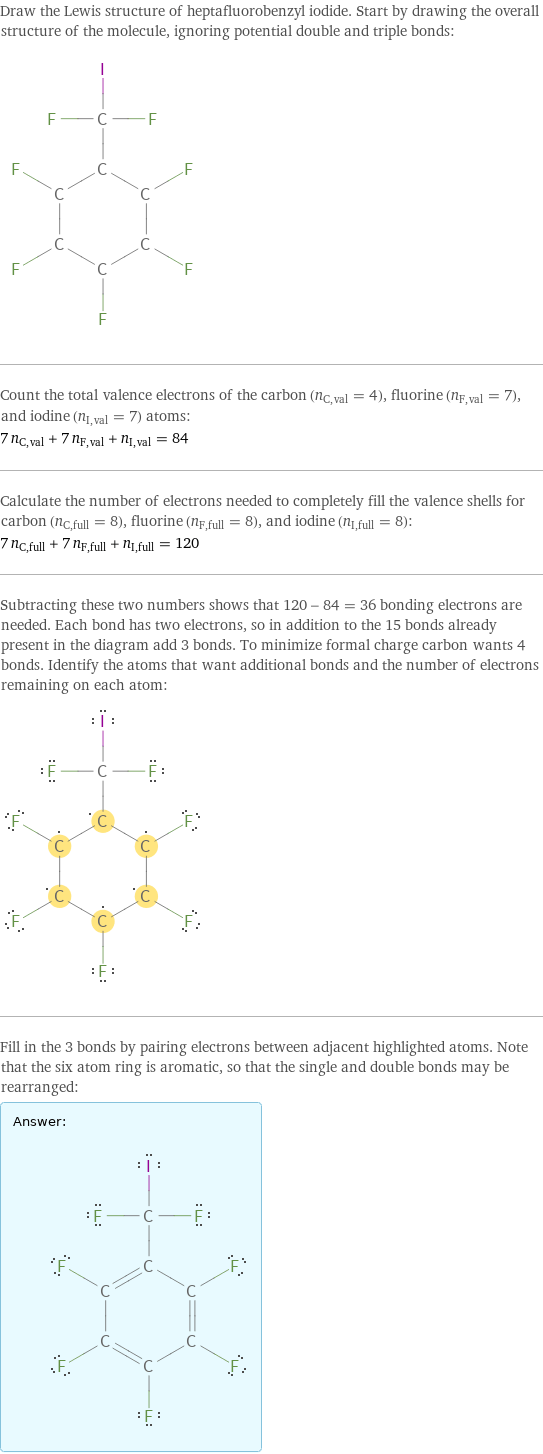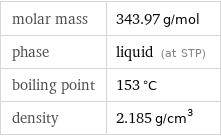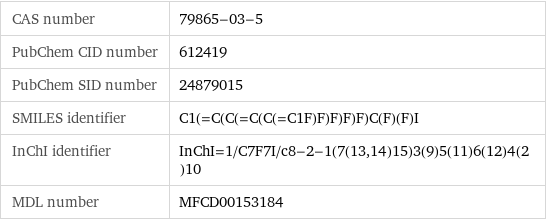Input interpretation

heptafluorobenzyl iodide
Chemical names and formulas

formula | C_7F_7I name | heptafluorobenzyl iodide IUPAC name | 1-(difluoro-iodomethyl)-2, 3, 4, 5, 6-pentafluorobenzene alternate names | 1-(difluoro-iodo-methyl)-2, 3, 4, 5, 6-pentafluoro-benzene | 1-(difluoro-iodomethyl)-2, 3, 4, 5, 6-pentafluorobenzene mass fractions | C (carbon) 24.4% | F (fluorine) 38.7% | I (iodine) 36.9%
Lewis structure

Draw the Lewis structure of heptafluorobenzyl iodide. Start by drawing the overall structure of the molecule, ignoring potential double and triple bonds: Count the total valence electrons of the carbon (n_C, val = 4), fluorine (n_F, val = 7), and iodine (n_I, val = 7) atoms: 7 n_C, val + 7 n_F, val + n_I, val = 84 Calculate the number of electrons needed to completely fill the valence shells for carbon (n_C, full = 8), fluorine (n_F, full = 8), and iodine (n_I, full = 8): 7 n_C, full + 7 n_F, full + n_I, full = 120 Subtracting these two numbers shows that 120 - 84 = 36 bonding electrons are needed. Each bond has two electrons, so in addition to the 15 bonds already present in the diagram add 3 bonds. To minimize formal charge carbon wants 4 bonds. Identify the atoms that want additional bonds and the number of electrons remaining on each atom: Fill in the 3 bonds by pairing electrons between adjacent highlighted atoms. Note that the six atom ring is aromatic, so that the single and double bonds may be rearranged: Answer: | |
3D structure

3D structure
Basic properties

molar mass | 343.97 g/mol phase | liquid (at STP) boiling point | 153 °C density | 2.185 g/cm^3
Units

Liquid properties (at STP)

density | 2.185 g/cm^3 refractive index | 1.47
Units

Chemical identifiers

CAS number | 79865-03-5 PubChem CID number | 612419 PubChem SID number | 24879015 SMILES identifier | C1(=C(C(=C(C(=C1F)F)F)F)F)C(F)(F)I InChI identifier | InChI=1/C7F7I/c8-2-1(7(13, 14)15)3(9)5(11)6(12)4(2)10 MDL number | MFCD00153184
Safety properties

flash point | 110 °C